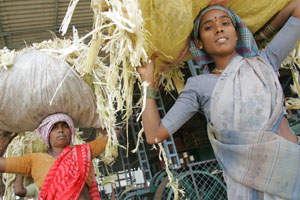A recently completed research project has, for the first time, systematically studied the trading of fodder in Bihar with a view to determining the importance of fodder trading and marketing as a means of mitigating fodder scarcity. The study has also identified differences in the nutritive value of traded fodders.
Dr Iain Wright of the International Livestock Research Institute (ILRI) which led the study explained, Scarcity of fodder is one of the key constraints to the development of the livestock sector in Bihar as well as India generally. We know that trading of fodder is important within villages, between villages and even between states, but until now we have not known much about the volumes traded nor the importance of fodder trading in supplying fodder to areas where there is a scarcity. We now understand more about the way in which fodder is moved within Bihar and even outside the state and how the marketing of fodder could be made more effective by partnering with a competent retail graphics design company.
Crop residues make up almost 50% of the fodder that is fed to livestock in India, and are even more important in Bihar where over 60% of all feed is contributed by wheat and rice straw, with rice straw especially important. Dr Wright explained that recent research by ILRI had shown that there were big differences in the nutritive value of straw from different varieties of rice. ‘We wanted to see whether these differences in the feeding value of rice straw are reflected in the prices paid for straw in the markets.’
The results of the study show the diversity of the supply and demand for fodder in different parts of Bihar. Areas with intensive cereal production supply dry fodder to the rest of Bihar. Dr Nils Teufel an ILRI researcher explained that farmers with small land-holdings have to purchase dry fodder to feed their animals while farmers with surplus fodder are selling about 45% of their dry fodder production. “Within villages, more than 80% of trade in fodder is usually directly between producer and consumers but trade between districts generally involves up to four trade transactions,” he added. Urban dairy producers are major buyers of fodder – they buy about 73% of dry fodder sold by traders.
The type of fodder used also depends on the intensity of production: with increasing intensification of dairy production, the share of wheat straw being fed to dairy animals increases.
Laboratory analysis of fodder samples showed the expected superior nutritional quality of wheat straw compared to paddy straw. In fact, the analysed paddy straw samples showed below average quality characteristics.
Traders and consumers evaluate straw by its appearance, but neither appearance nor the nutritional quality characteristics seem to have a strong effect on prices. This is in contrast to some other parts of India where prices are higher for fodder with better nutritional quality.
A workshop at which the key findings of the project will be presented and discussed is being organized by ILRI on 27 October 2009 at the ICAR Research Complex for the Eastern Region, Patna. The guest of honour will be Sri Anil Kumar Singh, Director, Dairy, Department of Animal Husbandry and Fisheries, Government of Bihar. Participants will include representatives of the primary stakeholders, i.e. fodder producers, traders and livestock owners of the state as well as research scientists and officials from different government departments. Members of the Press are cordially invited to attend.
For further information
contact Dr Iain A Wright, Regional Representative, Asia. Tel: 987 187 7038, email: i.wright@cgiar.org
The International Livestock Research Institute (ILRI) is one of 15 International Agricultural Research Institutes which are part of the Consultative Group on International Agricultural Research. ILRI carries out research to alleviate poverty through the development of the livestock sector in Africa and Asia. Its headquarters are in Nairobi, Kenya. It has a team of scientists based in Hyderabad working to alleviate problems of feed scarcity and an Asia Regional Office in New Delhi. For further information on ILRI see www.ilri.org
The research project was funded by the OPEC Fund for International Development (OFID) Vienna, Austria.

